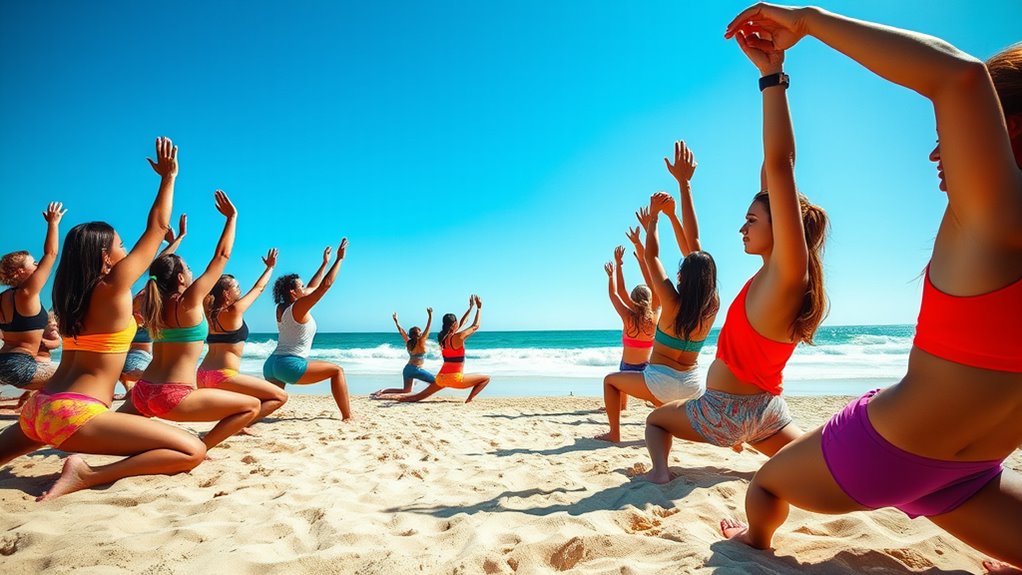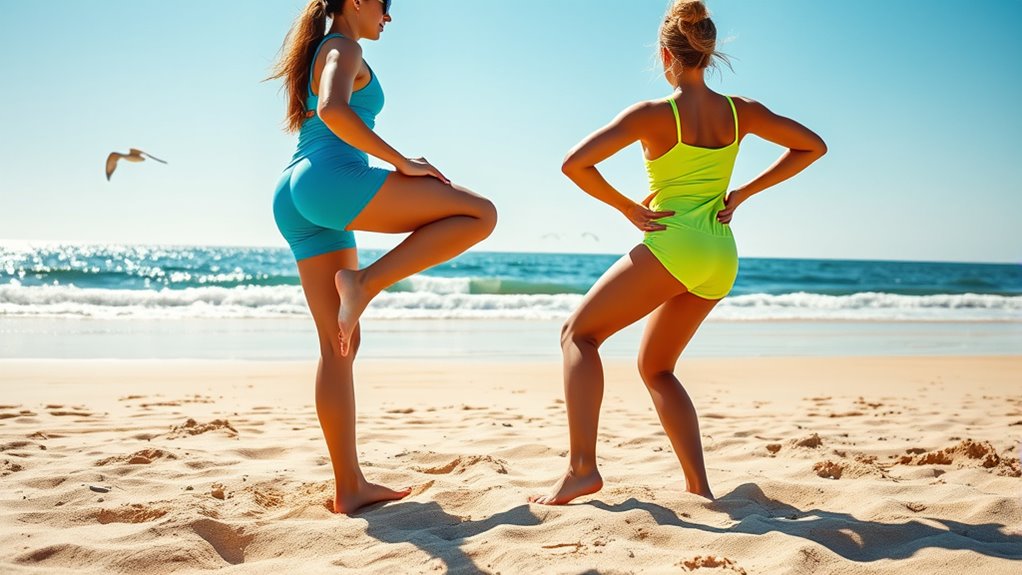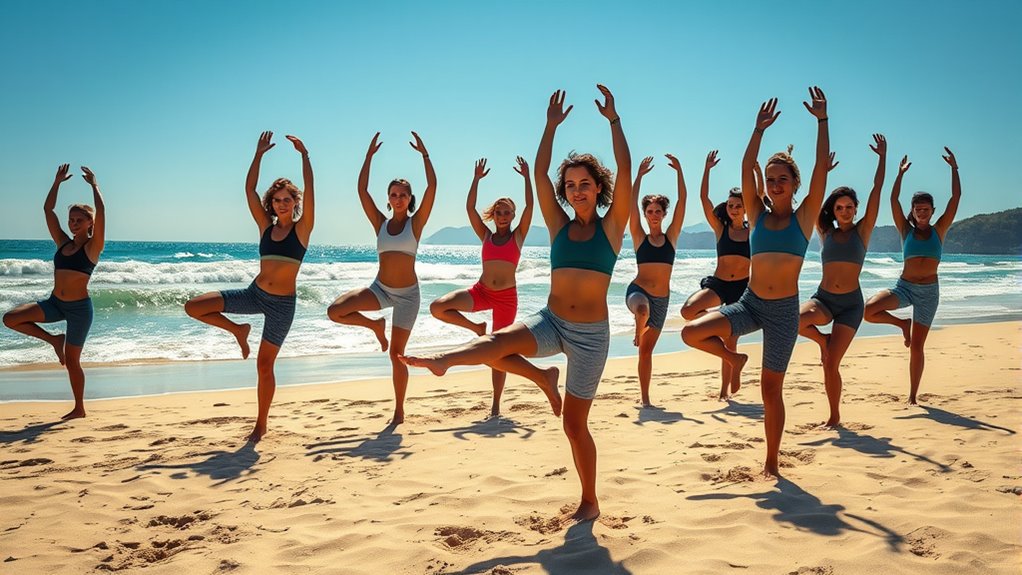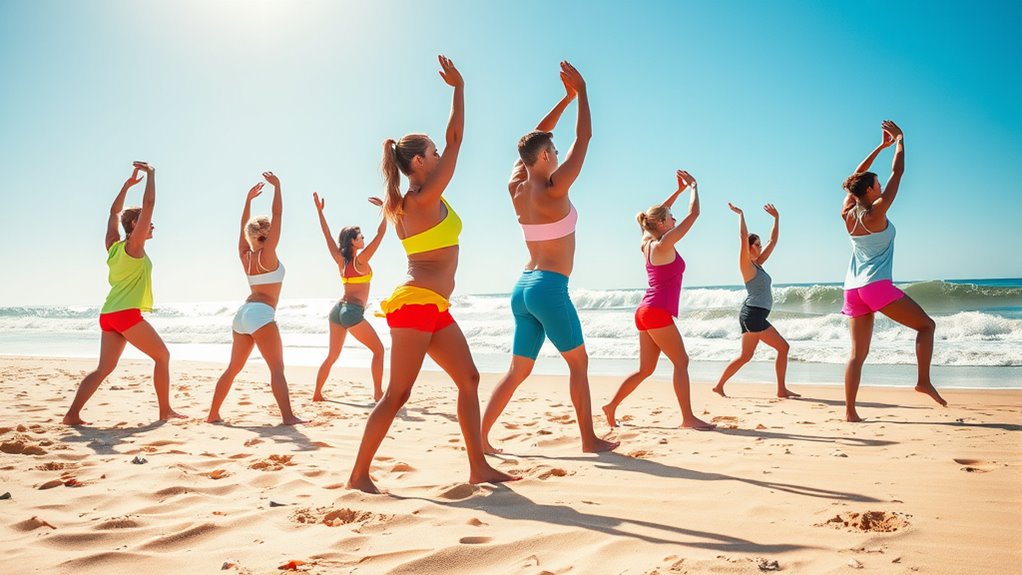To get ready for beach activities, start with dynamic stretches like leg swings and hip rotations to loosen your hips and hamstrings. Incorporate arm circles and shoulder rolls to prepare your upper body. Add light cardio such as brisk walking or jogging in place to increase blood flow. Finish with torso twists and balance drills like single-leg stands to improve stability. Keep moving smoothly—if you continue exploring, you’ll find more effective warm-up tips to boost your performance and prevent injuries.
Key Takeaways
- Incorporate dynamic movements like leg swings, walking lunges, and high knees to activate muscles and increase blood flow.
- Perform upper body warm-ups such as arm circles and shoulder rolls to improve shoulder mobility and reduce tension.
- Use lower body exercises like hip rotations and torso twists to enhance joint flexibility and core stability.
- Include light cardio activities such as jogging in place or jumping jacks to elevate body temperature and prepare muscles.
- Add balance drills like single-leg stands and heel-to-toe walks to improve stability and prevent injuries during beach activities.
Dynamic Stretches to Loosen Up

To prepare your muscles for exercise, dynamic stretches are an effective way to loosen up. They involve moving parts of your body through a full range of motion, gradually increasing your heart rate and blood flow. As you perform these stretches, you’ll activate muscles you’ll use during your beach activities, reducing the risk of injury. Start with leg swings, swinging each leg forward and back, then side to side. Next, do walking lunges, stepping forward into a lunge with each step. High knees and butt kicks are also excellent to engage your lower body. Keep the movements controlled, and avoid bouncing or jerking. Incorporating proper projection technology setup can enhance your viewing experience during beach movie nights. These stretches warm up your muscles efficiently and prepare your body for more intense activity. Recognizing the importance of fatherhood in shaping character can also inspire a positive mindset before engaging in physical activities. Additionally, understanding the tax implications of Gold IRAs can help you make informed decisions about your investments before planning your financial future. Engaging in remote hackathons can also be a fun way to challenge yourself and develop new skills while relaxing at the beach. To further optimize your preparation, consider utilizing exercise tracking apps to monitor your progress and stay motivated.
Arm Circles and Shoulder Rolls

Have you ever wondered how to effectively loosen up your shoulders before a workout? Arm circles and shoulder rolls are simple, yet powerful, movements that prepare your muscles for activity. To do arm circles, stand tall, extend your arms to the sides, and make small circles forward for 10-15 seconds, then switch to backward circles. Shoulder rolls involve lifting your shoulders toward your ears, then rolling them back and down in a smooth motion. Repeat this several times to relieve tension and increase circulation. These exercises improve shoulder mobility, reduce the risk of injury, and help you feel more comfortable during beach activities. Incorporating these warm-up exercises can also be beneficial for kinesiology principles that promote proper movement patterns and injury prevention, ensuring your shoulders are ready for movement and fun in the sun. Additionally, maintaining muscle flexibility through warm-up routines enhances overall athletic performance and reduces muscle strain, supporting joint health for sustained activity and comfort. For optimal results, consider dynamic stretching to further prepare your muscles and joints for active movement.
Leg Swings and Hip Rotations

Before diving into more intense activities, performing leg swings and hip rotations can considerably enhance your mobility and prepare your lower body. Stand next to a wall or sturdy surface for support. Swing one leg forward and backward, keeping it straight and controlled, to loosen your hip flexors and hamstrings. Then, swing your leg side to side across your body to activate your hip abductors and adductors. For hip rotations, stand with feet shoulder-width apart, place your hands on your hips, and rotate your hips in slow circles clockwise and counterclockwise. These movements increase blood flow, improve joint range of motion, and reduce injury risk. Incorporating 10-15 swings and rotations per leg to effectively warm up your hips and legs. Incorporating joint mobility exercises can further optimize your warm-up routine and enhance overall flexibility. Additionally, engaging in dynamic stretching can help prepare your muscles for more vigorous beach activities. To maximize effectiveness, consider adding muscle activation techniques before your workout, which can also support muscle endurance during activity. Including balance exercises may further improve stability and prevent falls during active beach days.
Light Cardio for Warmth

Starting with light cardio is an effective way to increase your body temperature and promote blood flow to your muscles. Activities like brisk walking, jogging in place, or jumping jacks get your heart rate up without overexerting you. These exercises help prepare your body for more intense movements by loosening stiff muscles and reducing injury risk. Keep the pace moderate, focusing on steady breathing and consistent motion. This warm-up boosts circulation, making your muscles more flexible and responsive during beach activities. Just a few minutes of light cardio can make a noticeable difference in your performance and comfort. Remember, the goal is to warm up, not tire yourself out. Once your body feels warmer and more energized, you’re ready for the next part of your warm-up routine.
Torso Twists and Side Bends

Torso twists and side bends help boost your core flexibility, making your movements smoother and more controlled. They also improve spinal mobility, which can reduce stiffness and discomfort. Plus, incorporating these exercises helps prevent muscle strain during your workout or daily activities. Engaging in these stretches can also support overall physical development by enhancing coordination and balance. Additionally, maintaining muscle flexibility through these exercises can contribute to better posture and reduce the risk of injuries. Regular practice can also reinforce trust in your body’s capabilities, leading to increased confidence during physical activities. Incorporating proper stretching techniques can further optimize your results and prevent overstretching or injury. Understanding the science behind muscle elasticity helps in applying these exercises more effectively to promote longevity and health.
Enhance Core Flexibility
To effectively enhance your core flexibility, incorporating torso twists and side bends into your warm-up routine can make a significant difference. These exercises stretch and engage your abdominal muscles, obliques, and lower back, preparing them for more active beach activities. Start with torso twists by standing with feet shoulder-width apart, rotate your upper body side to side, keeping your hips stable. Then, perform side bends by standing tall, reaching one arm overhead, and leaning sideways to stretch your obliques. Focus on slow, controlled movements to maximize flexibility gains. Consistent practice improves muscle elasticity, reduces injury risk, and increases your range of motion. Incorporating these exercises into your warm-up can also help you incorporate figurative language techniques, making your movements more expressive and fluid during activities. Additionally, understanding muscle elasticity can help you optimize your stretching routines for better performance and injury prevention, especially when considering performance tuning principles to enhance your overall physical readiness. Exploring dog names can also add a touch of personality and fun to your training routines, making your workout sessions more enjoyable.
Improve Spinal Mobility
Enhancing your spinal mobility is essential for maintaining good posture and reducing stiffness, especially before engaging in active beach sports. When you perform torso twists and side bends, you loosen up your spine, making movement smoother and reducing the risk of injury. These exercises target the muscles surrounding your vertebrae, increasing flexibility and circulation. Imagine yourself twisting to grab a ball or bending sideways to reach for your towel—these movements become easier and more comfortable. As you move through these stretches, you’ll notice a greater range of motion and less tension in your back. Incorporate these simple exercises into your warm-up to prepare your spine for all the dynamic activities on the sand. Your body will thank you for the added mobility and comfort.
Prevent Muscle Strain
Performing torso twists and side bends during your warm-up helps prevent muscle strains by activating and loosening the surrounding muscles before you start playing. These movements increase blood flow and improve flexibility, reducing the risk of overstretching or pulling muscles during activities. Focus on controlled, gentle motions to avoid injury. To help visualize, here’s a quick guide:
| Exercise | Target Area | Benefits |
|---|---|---|
| Torso Twists | Obliques, Spine | Enhance rotational mobility |
| Side Bends | Lateral torso muscles | Stretch and strengthen sides |
| Combined Movements | Full torso | Prepare muscles for activity |
Incorporate these exercises into your warm-up to stay limber and prevent muscle strain, ensuring a safe and enjoyable beach day.
Balance and Stability Drills

Balance and stability drills are essential for improving your overall coordination and reducing the risk of injuries. These exercises strengthen your core and ankle muscles, helping you stay steady on uneven surfaces like sand or rocky beaches. To do this effectively, you can incorporate simple yet effective movements.
- Stand on one leg, holding your position for 30 seconds, then switch sides.
- Practice heel-to-toe walks along the shoreline.
- Use a balance board or cushion to challenge your stability.
- Perform plank variations to engage your core muscles.
These drills enhance your proprioception, making you more aware of your body’s position. Incorporate them into your warm-up to improve your balance during beach activities, whether you’re surfing, volleyball, or just relaxing by the water.
Frequently Asked Questions
How Long Should I Perform Warm-Up Exercises Before Beach Activities?
You should perform warm-up exercises for about 5 to 10 minutes before heading to the beach. This helps loosen your muscles and increase blood flow, reducing injury risk. Focus on dynamic movements like arm circles, leg swings, and gentle jogging. Pay attention to your body’s signals and don’t rush. A proper warm-up primes your muscles for activity, ensuring you’re ready to enjoy beach fun safely and comfortably.
Are There Warm-Up Routines Suitable for Children or Seniors?
Ever wonder if kids or seniors can safely do warm-up routines? Absolutely! You should choose gentle, low-impact exercises like stretching or slow walking. For children, playful movements work well, while seniors benefit from chair stretches or light arm circles. These routines prepare their bodies without strain. Isn’t it important to keep everyone safe and active? Tailoring warm-ups to their needs helps prevent injuries and makes beach fun more enjoyable for all ages.
Can Warm-Up Exercises Prevent Injuries During Beach Sports?
You can substantially reduce your risk of injuries during beach sports by doing warm-up exercises. These routines prepare your muscles and joints for activity, increasing flexibility and blood flow. When you warm up properly, you lessen the chances of strains, sprains, and other injuries. So, before jumping into volleyball or surfing, take a few minutes to stretch and warm up—your body will thank you for it.
What Equipment, if Any, Is Recommended for Warm-Up Routines?
You don’t need special equipment for warm-up routines; your body weight usually suffices. Focus on dynamic stretches like leg swings, arm circles, and gentle jogging to prepare your muscles. If you want extra support, use items like resistance bands or light dumbbells for added intensity. Just make sure whatever you use is safe and comfortable, helping you warm up effectively without risking injury.
How Often Should I Repeat Warm-Up Exercises for Optimal Results?
You’re asking how often to repeat warm-up exercises for the best results. Think of it as hitting two birds with one stone—you prepare your muscles and avoid injury. Usually, doing a warm-up 10-15 minutes before your activity, and repeating it every hour if you’re staying active, works well. Listen to your body; if you feel tight or tired, don’t be afraid to warm-up again to stay loose and ready.
Conclusion
Warming up is essential before hitting the beach, and you’ll see a difference in your comfort and performance. Did you know that a proper warm-up can reduce injury risk by up to 50%? So, take just a few minutes to do those dynamic stretches and light cardio. It’ll boost your energy, improve your balance, and make your beach day more enjoyable. Get ready, stay active, and soak up the fun!










